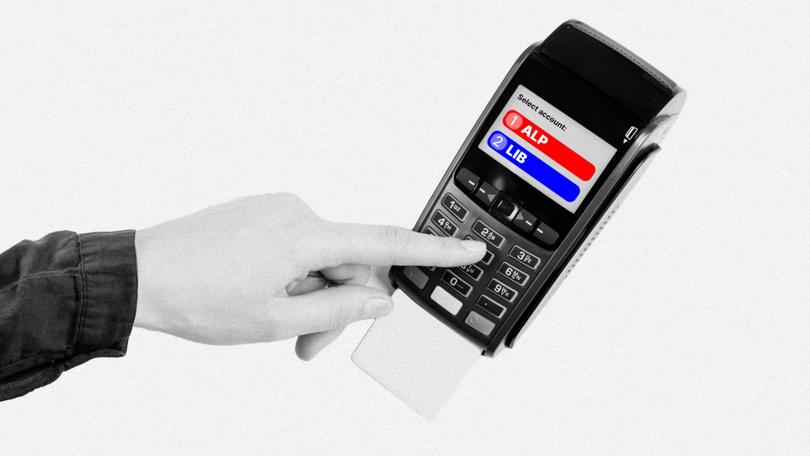Federal election 2025: Saddle up for the spendathon kids - you’ll be paying for it

Buckle up young voters, the great election spendathon is on and you will be the ones picking up the tab.
Fresh from committing $1.8 million per worker to save 1100 jobs in Whyalla, the Government is using your credit card to shore up seats on the city fringes.
If you hadn’t noticed, dear millennial, this election is on a knife edge, and with Labor sitting on just 31 per cent of the primary vote compared to the Coalition’s 41 per cent, according to the latest Freshwater poll. On a two-party preferred basis, the Coalition leads 52 per cent to 48 per cent.
Sign up to The Nightly's newsletters.
Get the first look at the digital newspaper, curated daily stories and breaking headlines delivered to your inbox.
By continuing you agree to our Terms and Privacy Policy.This election will come down to a handful of seats and very likely a negotiation with the independent crossbenchers over who will form a minority government.
With 70 per cent of voters citing cost of living as their main concern, Labor will be throwing borrowed money at any policy that takes the sting out of prices.
They know that every government that was in power during the post-pandemic inflation spike has been turfed out of power and have made this $8.5 billion Medicare handout the “beating heart of our campaign.” It takes up the full $5.4b set aside in the mid-year Budget update but expect this beating heart to grow arms and legs that will also cost taxpayers as the election rolls on. They didn’t mention how to pay for it.
The Coalition immediately matched the program, backflipping on the fiscal restraint that shadow spokesperson for economics Angus Taylor had earlier promised to The Nightly. Mr Taylor said the full details of where the savings will come from will be announced when the election is.
So far in this campaign that’s not yet a campaign, Labor has committed $7.2b for the Bruce Highway in Queensland, $3b for the NBN, $2b for the Clean Energy Finance Corporation, $1.9b for saving the Whyalla steelworks, $1.7b for state funding for hospitals and $2b for green aluminium production credits.
There’s also extra cash to get apprentices into the construction industry and more money for closing the gap for Indigenous Australians and for women’s health.
All that is on top of extra spending that was revealed in the mid-year review including cost-of-living top-ups such as energy and childcare rebates that will add $20b over the next four years, “unavoidable and automatic” payments for aged care, health care, and pensions, that will require an additional $22b, and the $5b plus debt relief under the HECS/HELP scheme that isn’t even means tested.
While some of the spending, such as the Medicare handout, is earmarked for after the election, the trajectory is clear. Despite promising “responsible fiscal management”, Labor is forecast to deliver a $26.9b deficit in this year’s budget. If it wasn’t for a low Australian dollar offsetting the fall in the US dollar denominated iron ore price, things would likely look much worse.
More importantly, dear Millennial, the country’s debt is set to surpass $1 trillion next year with no sign of real spending restraint and an ageing population that will increasingly require more health services and indexing for the aged care pension.
The interest payments on that debt are projected to grow by 11 per cent annually over the next decade.
Speaking on ABC radio this morning, finance minister Katy Gallagher talked the Government’s record of banking revenue upgrades in the previous two budgets but said little about where the money would come from for this latest expenditure, saying they’d “put in some small revenue measures.”
That is what worries Saul Eslake, former chief economist of ANZ, who had also worked with Jeff Kennett in cutting Victoria’s debt surplus.
“Chalmers and Gallagher have banked most of (the revenue gains). But what they haven’t done is make any serious attempt to cut spending, and nor have they made any serious attempt to raise longer term revenues,” he said.
“The commodity windfalls that have helped deliver the two budget surpluses we’ve had are going away, and so we’re going back into deficit.”
The youth tax
This is the first election where Gen X and Millennial voters will outnumber Boomers, but you wouldn’t know it based on how they are being targeted.
This cohort will be footing the bill for decades to come, and without spending restraint, or a complete overhaul of the tax system, the only way that it will be paid for is via bracket creep.
Australia’s revenue collection system is one of the most reliant on personal income taxes in the OECD, which means young wage earners will be responsible for increasingly large share of the tax take, subsidising generous tax concessions to the most well off, most likely older voter.
The mid-year economic and fiscal outlook showed there were $50 billion of tax concessions over the forward estimates for capital gains tax discounts that primarily benefited the richest in the country and superannuation tax concessions that primarily benefited those in the top income tiers.
Last week former Treasury Secretary Ken Henry declared that future generations were being “mugged” by successive governments that have breached “the principles of sound fiscal management.”
The former Rudd adviser and an architect of sweeping review of Australia’s tax system believes the lack of restraint of government spending is a “looming intergenerational tragedy” that will rely on bracket creep to pay the bills.
“If you wanted a tax system to punish the young, this is what you’d do.”
Plenty of those youth will also be paying for profligate spending by state governments too with ratings agency S&P Global warning gross debt across the states is expected to hit $785 billion by 2027, driven unsustainable spending on cost-of-living subsidies, infrastructure budget blowouts, and public service outlays.
Mr Eslake, a Tasmanian, said that had been the case in his state.
“It would seem that the two major parties are lining up to do what to the Federal Budget what the Liberals in Tasmania have done over 10 years to the Tasmanian budget, which is at every election promise to spend lots of money on things that are popular without saying a word as to how it would be paid for,” he said.
“The result of that has been that Tasmania now has a worse financial situation than Victoria, which everybody seems to know is a basket case.”
While the Federal Budget is different from the States, the lesson is apt. The Reserve Bank last warned that China, our most important source of income to pay for all that spending is slowing. The once in a century boom that was China’s industrialisation is over, and the demographic drag will only accelerate.
Which puts you even more on the hook, dear Millennial. I know that tax is boring, and I’m sure you’d like a free trip to the doctor - even if you are the least likely to use it - but check with your elected representative about who is ultimately signing the bill.

